
Edward Winter
One method of indicating a computer’s strength is to pit it against itself, in Auto mode. Below is the result that we had in 1982 when Mark V was made to play White and Black, at a rate of 40 moves in 2½ hours:
1 d4 Nf6 2 c4 c5 3 d5 e6 4 Nc3 exd5 5 cxd5 d6 6 e4 g6 7 Bd3 Bg7 8 f4 O-O 9 Nf3 a6 10 O-O b5 11 Bd2 Nbd7 12 e5 dxe5 13 fxe5 Ng4 14 e6 fxe6 15 dxe6 Nde5 16 Nxe5 Qd4+ 17 Kh1 Rxf1+ 18 Qxf1 Nf2+ 19 Qxf2 Qxf2 20 e7 Bb7 21 Ne4 Qd4 22 Bc3

22...Qd5 23 Nxg6 hxg6 24 Rd1 Bxc3 25 Bc4 Qxc4 26 Rd8+ Kg7 27 e8(N)+ Kh8 28 Rd1 Qxe4 29 Rg1 Rxe8 30 h3 Be5 and Black mates in two moves.
(171)
Our thanks to Geoffrey Egan (Edmonton, Canada) for a copy of The New Yorker of 9 March 1987. This contains a massive article on computer chess entitled ‘A Reporter at Large’ by Brad Leithauser (pages 41-73).
(1388)
In 1989 Garry Kasparov offered some comments on chess computers in an interview with Thierry Paunin on pages 4-5 of issue 55 of Jeux & Stratégie (our translation from the French):
‘Question: ... Two top grandmasters have gone down to chess computers: Portisch against “Leonardo” and Larsen against “Deep Thought”. It is well known that you have strong views on this subject. Will a computer be world champion, one day ...?
Kasparov: Ridiculous! A machine will always remain a machine, that is to say a tool to help the player work and prepare. Never shall I be beaten by a machine! Never will a program be invented which surpasses human intelligence. And when I say intelligence, I also mean intuition and imagination. Can you see a machine writing a novel or poetry? Better still, can you imagine a machine conducting this interview instead of you? With me replying to its questions?’
(1802)
From Bob Meadley (Narromine, NSW, Australia):
‘I can't say I agree with Garry Kasparov on chess computers. How many times have we read about the machine-like play of Capablanca and the cautious play of Petrosian? Why cannot a chess program contain soundness of technique and strategy without originality? In other words, pragmatism. There have been some dull chess champions. A computer was world backgammon champion, and that is because it can work out the odds of the dice throws better than a human. I hope Kasparov is right, but when the programmers are able to convert a computer to look at 700,000 board positions a second and then discard the majority just as quickly to concentrate on the desired positions, we will be in trouble. Already there is a good floppy disc programme by Tom Doher (1988) which plays a fair game and has 15 levels. And I believe the “Coffee-House Chess Monster” from the Enlightenment Company is even stronger on floppy. “Deep Thought” is ranked 30th in the US now.’
A contribution from Ludwig Steinkohl (Bad Aibling, Federal Republic of Germany):
‘Are your readers in favour of banning computers from ordinary chess tournaments, so that they have to play in special events set up for them? If so, what are their arguments? Or do your readers suggest that humans and computers should play in the same tournaments? In German, Austrian and Swiss tournaments, it happens that players refuse to play computers because they want to climb the Elo ladder, which you can’t do playing computers. Should computers therefore get Elo ratings, just like humans?
And how about correspondence chess? You don’t hear anymore that computers will kill it. Computers are accepted as theory books and other means are used, but are they of any help to correspondence chess players? Some say that letting a computer analyze all night does not achieve anything.
Many chess magazines support computer chess in their computer section and refuse it in the remaining parts. What is missing is an open-minded discussion of these subjects. Enlightenment is needed, and C.N. can do a good job.’
(1862)
Perhaps the real question that will determine in due course whether Kasparov was right about computers is the extent to which they can be programmed to ‘judge’ long-term strategical planning or, alternatively, the extent to which they become so strong at analysing variations that their inability to undertake long-term strategical planning will be an insignificant weakness by comparison. These thoughts have recently been reinforced as we looked over Capablanca’s notes to his victory against Alekhine at Nottingham, 1936, which first appeared in the Russian Tournament Bulletin (special issue of 64), No. 5, 24 August 1936, page 2:

Position after 38 a4
Here Alekhine resigned. Capablanca wrote what may be regarded as a brilliant exposition of White’s winning procedure (translation by K.P. Neat):
‘In this position the game was adjourned, and was resigned a few days later without being resumed. White can win in various ways, the most “scientific” being as follows: place his bishop at c3 (during this time Black can only make waiting moves), and then advance his h-pawn to h5; Black will have to keep his king either at h6, or (after advancing his pawn to h6) at h7 (the latter is of course stronger). In both cases White will place his bishop at h3, forcing Black to defend the f5 pawn with his rooks. With his king at h7, Black will have to move his king between h7 and g8. White will transfer his king to f3 and, when the black king is at g8, transfer his knight from g3-fl-e3-d5, when Black will be forced to defend the b6 pawn with one of his rooks. White then gives a check at f6, forcing Black to give up the exchange. White will then carry out a further regrouping and place his bishop at d5, while holding the long diagonal with his other bishop from c3. Black will again end up in a stalemate [sic] position, and hence White will win another pawn, after which Black’s resistance will be overcome.’
So that is what Capablanca would have done. We should be interested to learn how the strongest computers would act in the diagrammed position.
(1892)
The above two items were published in 1989, was the following one.
Richard Lappin (Jamaica Plain, MD, USA) sends the Fischer column in Boys’ Life, August 1968.
After explaining in detail ‘why your solutions to the very tough puzzler in March [sic] were wrong’, Fischer answers a reader who wants to know, ‘Have you ever played a computer? What do you think of the chance of a computer of grandmaster strength, and possibly becoming world champion?’ Fischer’s reply:
‘I’ve never played a computer. Eventually, though, I think a computer can become champion. After all, it can’t be as hard as getting a man on the moon. But I hope it doesn’t happen during my lifetime! Incidentally, here’s an example of a computer game. Black’s game was a disgrace to the human race. The computer (White) was called MacHack IV, and it took on Landey, the man.’
White: MacHack IV – Black: Landey
Sicilian Defence
(Notes by Fischer)
1 e4 c5 2 d4 cxd4 3 Qxd4 (Leads to loss of time. Try to avoid early queen moves. 3 Nf3 was better.) 3...Nc6 4 Qd3 Nf6 5 Nc3 g6 6 Nf3 d6 7 Bf4 e5? (Anti-positional, weakens square on d5.) 8 Bg3? (8 Bg5 pinning knight and indirectly gaining control of d5 was logical.) 8...a6 9 O-O-O b5 10 a4 Bh6+? (Bad because it removes the d-pawn’s protection – the machine takes advantage of this. Simply 10...bxa4! and Black’s still OK.) 11 Kb1 b4 12 Qxd6! Bd7 13 Bh4! Bg7 14 Nd5 Nxe4 15 Nc7+ Qxc7 16 Qxc7 Nc5 17 Qd6 Bf8 18 Qd5 Rc8 19 Nxe5 Be6 20 Qxc6!! Rxc6 21 Rd8 mate (A very powerful finish by the machine.)
After replying to questions regarding checkmate and the touch-move rule, Fischer annotates the blunder-ridden game of a reader (Ron Hill of Grant’s Pass, Oreg.) and gives a three-mover by ‘Albert Renn, Kassel, Germany’.
(1893)
The ICCA Journal is a very well produced quarterly publication from the International Computer Chess Association (Maastricht, the Netherlands).
The July-September [1988] issue, just out, is another excellent one. The contributors’ erudition is such that a fair amount will pass over the non-specialist’s head. There is, however, a most entertaining article entitled ‘Life with ChessBase’ by John Nunn, explaining how a grandmaster uses technology in his preparation.
(1784)
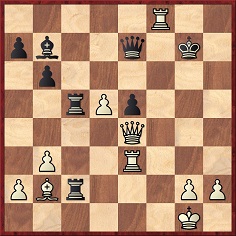
This position (White to move) came about after Black’s 30th move in Zukertort v Blackburne, London, 1883, one of the most famous games.
Zukertort won with 31 Bxe5+, a move attributed two exclamation marks by Reinfeld on page 34 of The Chess Masters on Winning Chess (New York, 1960). However, a forced mate in seven with 31 Rg8+ had already been put forward by Edgard Tchélébi of Beirut (1928-63) on page 60 of the March 1957 BCM.
It may not be long until somebody brings out a book of computer ‘busts’ of famous positions, and some general questions are worth contemplating. Are such faster wins ‘important’? Should annotators systematically look for, and point out, these discoveries? Should the use of a computer, and perhaps even its identity, always be acknowledged? Should new editions of old books aim to represent ‘the current state of knowledge’?
For the record, our 25-franc chess CD-ROM Jeux d’échecs (Micro Applications, Paris, 1996) had put its finger, or whatever, on 31 Rg8+ almost before we had set our stop-watch going.
(2193)
From Martin Sims (Palmerston North, New Zealand):
‘Are faster wins important and should they be pointed out by annotators? Yes. The search for truth is important and never-ending. Finding a bust in no way devalues the creative efforts of an earlier game; chess is a sport/struggle, and mistakes will be made. They certainly are made now, and we don’t complain, so why worry about the search for truth in an older masterpiece?
To the third question, also yes. The identity of software and hardware gives a clue as to the accuracy of the analysis.
Finally, should new editions of old books aim to represent the current state of knowledge? No. Nunn is creating new books when he “corrects” Alekhine and Fischer. I am happy to read his analysis, but he has created a new work. If he had stopped after turning these works into algebraic, that would have been fine, but as soon as he changes one note, one line of analysis or one word then he has created something that is his and not the original author’s.’
(2228)
A continuing cause for surprise is how many published combinations are revealed by computers not to have featured the best possible play. The position below (White to move) appeared on page 119 of the April 1930 Deutsche Schachzeitung:
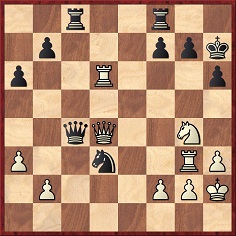
Mittelmann-Clausen, Altona, 1928
Play went 1 Rxh6+ gxh6 2 Nf6+ Kh8 3 Rg7 (‘!!’) Kxg7 4 Ne8+ Kg6 5 Qf6+ Kh5 6 Ng7 mate.
Our little CD-ROM, the star of C.N. 2193 above, swiftly produced a forced mate in four, beginning with 1 Nf6+ Kh8 2 Rxg7.
Now a game from pages 156-157 of Miron Hazeltine’s Brevity and Brilliancy in Chess (New York, 1866):
Philip Richardson-N.N.
Occasion?
Petroff Defence
1 e4 e5 2 Nf3 Nf6 3 d4 Nxe4 4 Nc3 Nxc3 5 bxc3 exd4 6 cxd4 Qe7+ 7 Be3 Qb4+ 8 Bd2 Qb6 9 Bd3 Be7 10 O-O O-O 11 c4 c5 12 d5 Bf6 13 a4 Bxa1 14 Qxa1 Qf6 15 Bc3 Qa6 16 Qb1 h6 17 Ne5 d6
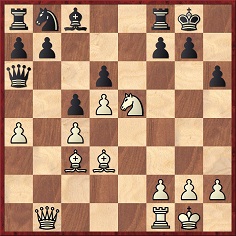
‘Will the reader pause here and see if he can win with the White forces in 15 moves, at most?’
18 Bh7+ Kh8 19 Ng6+ Kxh7 20 Nxf8+ Kg8 21 Qh7+ Kxf8

22 Qxg7+ Ke7 23 Re1+ Be6 24 Rxe6+ Kd8 25 Bf6+ Kc7 26 Re7+ Nd7 and ‘White announces mate in six moves’.
In the second diagram above, the CD-ROM almost immediately pointed out that after 22 Qxg7+ it is mate in a further four moves. The Fritz program indicated back at move 18 that 18 Bh7+ gave mate in nine moves.
(2270)
A forgotten position from a game between Marshall and the composer Kubbel:
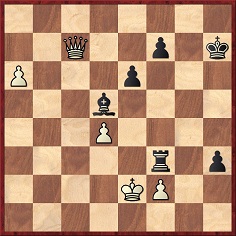
Black to move
F.J. Marshall (simultaneous) v K.A.L. Kubbel, Gatchina, 11 May 1914
Pages 304-305 of the October 1914 Deutsche Schachzeitung gave an account based on Kubbel’s own annotations in the St Petersburger Herold and summarized here. Eschewing the clear draw with 47…Kg6 and 48…Ra3, Black sought complications through 47...Rf5 48 a7 e5 49 Qd7 (‘49 Qe7 also came into consideration.’) 49…Bf3+ 50 Kd2 (‘Instead of this 50 Ke3 would have been stronger. After 50…exd4+ White cannot capture with the king since he would lose both his queens by 51 Kxd4 Rd5+ 52 Qxd5 Bxd5 53 Kxd5 h2 54 a8(Q) h1(Q)+, but after 51 Qxd4 Black’s situation would be much worse. For example, 51…Bg2 then loses at once to 52 Qd3 Kg6 53 f3.’) 50…Kg6 51 d5 h2 52 a8(Q) h1(Q) 53 Qg8+ Kh6 54 Qh8+ (‘If 54 Qd6+ then 54…Kh5! However, after 54 Qxf5 Black draws with 54…Qd1+, followed by 55…Qd4+ and 56…Be4+ or 56…Bxd5+. Amusing!’) 54…Kg6 (‘Naturally not 54…Kg5 owing to 55 Qg7+.’) 55 Qd6+ f6 56 Qg8+ Kh5! 57 Qh7+

(‘An original position. Despite his two queens, White cannot win. The black king slips away from all danger like an eel, and White finally has nothing left but to exchange.’) 57…Kg5 58 Qxh1 Bxh1 59 Qc5 Bxd5 60 Qxd5 Rxf2+ 61 Ke3 Rf4 Drawn.
And yet our little CD-ROM Jeux d’échecs shows that White had a forced mate in five with 55 Qc6+ f6 56 Qce8+ Kg5 57 Qhg8+ Kf4 58 Qa4+ e4 59 Qg3 mate.
(2198)
Our CD-ROM was out of its depth in verifying a mate in ten which Berthold Suhle (1837-1904) announced in a game, one of eight played in a simultaneous blindfold display, against Kronenberg in Bonn on 20 December 1858:
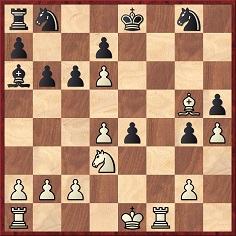
White to move
24 O-O-O c5 25 Rde1 Bb7 26 Ne5 Bd5 27 Ng6 Bf7 28 Re4+ Ne7 29 Bxe7 Nc6 30 Bg5+ Ne7 31 Bxe7 any 32 Bg5+ Be6 33 Rf8 mate.
Sources: Deutsche Schachzeitung, January 1859, page 30 and the Chess Player’s Chronicle, 1859, pages 71-72. The Chronicle wrote of Suhle, ‘a new star has also appeared on the chess horizon which threatens to dim the light of the Morphy star’. It is certainly rare to find an (alleged) announced mate which begins with castling, especially on the queen’s side and without check.
(2199)
We should be interested to learn how various strong computers react in the following position:
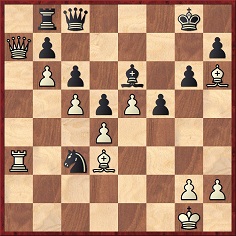
White to move
A. Selesniev v C. von Bardeleben, 4th match-game, Berlin, 5 February 1920
Play went 36 Rxc3 Ra8 37 Ra3 Rxa7 38 bxa7 Qa8 39 Bg5 Resigns. The annotator, Sämisch, remarked that White wins easily by bringing his bishop to b8.
Source: Deutsches Wochenschach, 25 April 1920, pages 90-91.
(2200)
A nomination made by Leonard Barden in 1967 for the best computer move:

This position, from a game between the Moscow Institute and Stanford University, appeared on page 187 of the June 1967 Chess Review. Barden’s view on White’s next move, 15 Rxh7, was quoted: ‘Undoubtedly the most brilliant move ever made by a computer’.
The Chess Review item, by J.S. Battell, ended:
‘We don’t know what brilliant moves may have been made by computers previously; but, in this game, the Moscow machine looms like a Morphy against a Duke of Brunswick and a Count Isouard. We do expect, however, that the future World Champion who takes on a computer will have a referee so stationed as to ensure against there being a Schlumberger behind the machine’s moves!’
(2234)
A news report by Harry Golombek on pages 8-9 of the January 1952 BCM:
‘My more mechanically minded readers will be interested to learn that a portable electronic brain, weighing a mere 500 pounds and costing only 80,000 dollars, has been developed by the Computer Research Corporation of Hawthorne, California. One of its designers, Richard Sprague, claims it can play unbeatable chess. Donald H. Jacobs, president of the Jacobs Instrument Company of Bethesda, Maryland, and himself developer of a 140-pound mechanical brain, proved sceptical and challenged the CRC-102 (the euphonious and imaginative name of the electronic midget brain) to a best of 20 games match, offering to bet 1,000 dollars on his ability to defeat the baby electronic brain without consulting his own mechanical brain for assistance. The CRC-102 declined the match hastily on the grounds that the “urgency for this machine in the defence effort makes such a tournament untimely”. Clearly history is engaged in its habitual process of repeating itself and we are faced once again with the Morphy-Staunton incident.’
(2646)
The device in question was discussed on page 34 of Chess Review, February 1953, where Robert H. Dunn quoted the following:
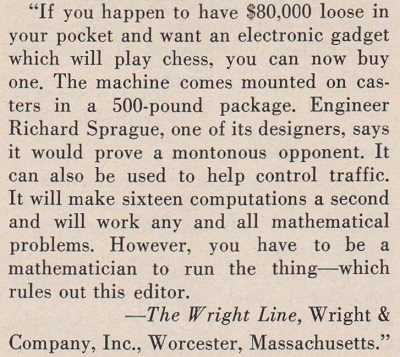
The following is Fred Reinfeld’s introduction to Tartakower v L. Steiner, Warsaw, 1935, on page 116 of Relax with Chess (New York, 1948):
‘When Professor Weiner [sic – Wiener] of the Massachusetts Institute of Technology invented a calculating machine which requires only one ten-thousandth of a second for the most complicated computations, he was quoted as saying, “I defy you to describe a capacity of the human brain which I cannot duplicate with electronic devices”.
Up to the time these lines were written, the Professor had apparently not yet perfected an electronic device capable of making such chess moves as Tartakower’s 20th in the following game. The day may yet come, however, when we shall see such books as ‘Robot’s 1000 Best Games’, or when chess tournaments will have to be postponed because of a steel shortage.’
Today’s computers find 20 Nxd8 instantaneously. As regards his 19th move, i.e. the sacrifice Nxf7, Tartakower wrote on page 61 of his second Best Games volume: ‘The art of chess is simple: you play Nf3-e5 and then, sooner or later, Nxf7 is decisive.’
(3177)
Jonathan Hinton (East Horsley, England) draws attention to the following passage by P.H. Clarke in his ‘From the USSR’ column on pages 117-118 of the April 1963 BCM:
‘Chess in 2000
Will the world champion in 2000 be a man or a machine? This was the subject for discussion on Moscow television recently by grandmasters Smyslov, Bronstein and Averbakh. As might be expected, no agreement was reached. Averbakh held that in about 35 years’ time scientists will be able to design a machine perfect enough to compete with masters and even grandmasters and that it will have many advantages over man. Smyslov was of a different opinion. He compared chess with music, asserting that just as a mechanical composer could not rival human fantasy, so a machine could not play better chess than a man.
Bronstein took a middle line, surmizing that by the year 2000 there would be separate championships for men and machines. I wonder who will be right.’
(3846)
Stuart Rachels (Tuscaloosa, AL, USA) compares the above with a comment of Smyslov’s, dated 30 April 2004, which is quoted on page 122 of The World Champions I Knew by Genna Sosonko (Alkmaar, 2013):
‘I’m working on a book – my 60 best games, I was looking at my game with Savon recently. And I found so many mistakes with the computer, just one mistake after another. And I considered that game one of my best … Yes, the computer can outdo anyone now.’
(8332)
From page 345 of The Personality of Chess by I.A. Horowitz and P.L. Rothenberg (New York, 1963):
‘That a richly endowed robot will one day be able to play a highly skillful game of chess leaves no room for doubt. On the other hand, in the absence of a fantastic superspeed electronic brain, the chess championship of the world is likely to be retained by humans for centuries to come.’
(4126)
From Nathan Bauman (Seoul, South Korea):
‘Regarding the first chess computer, a king and rook versus king problem-solving machine invented by Leonardo Torres y Quevedo (1852-1936), I would draw your attention to a recent article I have written, “A New Photograph of ‘El jugador ajedrecista’, the World’s First Chess Computer”.
I wonder whether any other pictures or clips can be found. There is very little visual material available on the Internet, and what does exist seems to have been conflated with a machine invented by Torres y Quevedo some years later.’
Any references that readers can provide will be appreciated. In the meantime, we note that some illustrations of Torres’ invention (a photograph and four diagrams) appeared on pages 227-229 of that much-neglected book Chess: Man vs Machine by B. Ewart (London, 1980).
Although Ewart noted that Torres’ machine (‘the first purely mechanical chess player’) was introduced to the public at the Sorbonne in Paris in November 1915, a number of chess computer books give the date of its invention as 1890. See, for example, page 11 of Computer Chess by L. Pachman and V.I. Kühnmund (London, 1986) and page 20 of I giocatori artificiali by P. Ciancarini (Mursia, 1992).
Concerning the subsequent generation (in terms of both computers and the Torres family), below is an item from page 94 of the February 1951 CHESS:
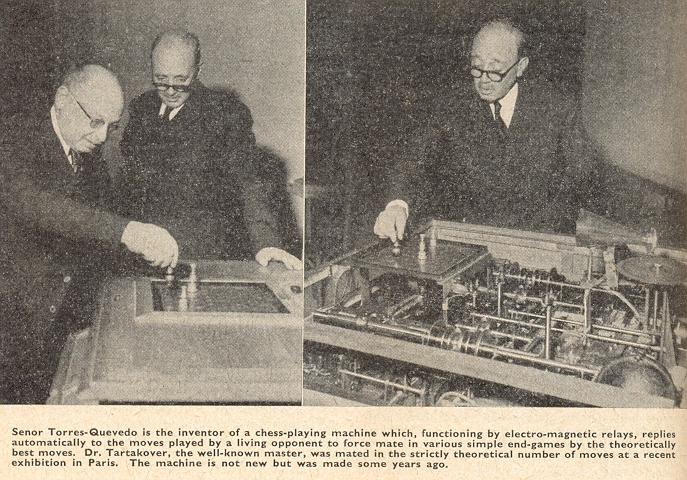
(4470)
From Christian Sánchez (Rosario, Argentina):
‘On the Internet I have found two reliable Spanish sources for information about the chess machines. One is a webpage of the Torres Quevedo Museum, where the two prototypes are preserved; there are pictures of both Ajedrecista machines. The other is an article by González Redondo; it has some illustrations of the first Ajedrecista and allows a chronology of the inventions to be drawn up:
1912: Leonardo Torres Quevedo began construction of the first Ajedrecista.
1914: The first Ajedrecista was exhibited in Paris.
1920: The second Ajedrecista was built by Gonzalo Torres Quevedo, under his father’s direction.
1922: The second Ajedrecista was exhibited in Paris.’
Calle Erlandsson (Lund, Sweden) points out that in 1955 Spain issued a postage stamp depicting the inventor:
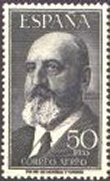
We note that the stamp was one of the illustrations in the section on the Spaniard on page 125 of Persönlichkeiten und das Schachspiel by Beat Rüegsegger (Huttwil, 2000).
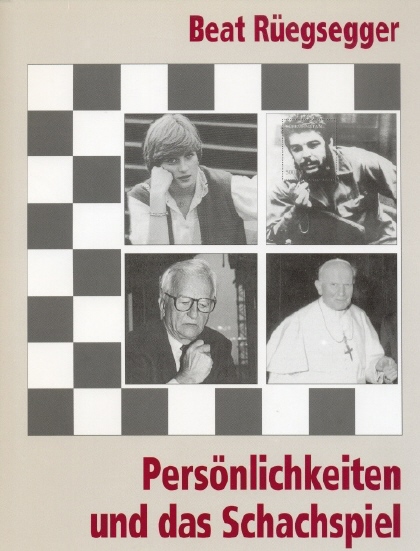
(4482)
Leonard Barden (London) comments that Torres’ invention was placed on view during the 1960 Olympiad in Leipzig. The photograph below appeared on page 253 of XIV. Schach-Olympiade Leipzig 1960, published by Sportverlag Berlin:

See also plate 1 in The Machine Plays Chess? by Alex G. Bell (Oxford, 1978).
(4495)
An unresolved matter from C.N. 4470 is why a number of computer chess books affirm that Leonardo Torres y Quevedo invented his chess computer as early as 1890, rather than in 1912-14.
The earliest claim about 1890 of which we are aware is on page 286 of Faster Than Thought edited by B.V. Bowden (London, 1953):
‘In about 1890 Signor Torres Quevedo made a simple machine – a real machine this time – which with a rook and king can checkmate an opponent with a single king.’
The Italianization does not inspire confidence, and no source for the information was offered.
Page 9 of The Machine Plays Chess? by Alex G. Bell (Oxford, 1978) stated:
‘Torres apparently built a prototype machine about 1890 which went through a number of sporadic refinements. His final version made its most publicized performance at the Paris World Fair in 1914 but it, understandably, sank into oblivion on the outbreak of World War I. So much for the discrepancy in dates.’
Can a reader move the matter on from the ‘apparently’ stage to some hard facts?
(4525)
It may be wondered when 1890 started to be mentioned in chess books as the year in which Leonardo Torres y Quevedo invented his chess computer. A relatively early instance is page 13 of Chess and Computers by David Levy (London, 1976), whereas page 3 of the same writer’s Computer Chess Compendium (London, 1988) gave only 1914.
(4547)
From opposite page 96 of Schach – mehr als ein Spiel by Herbert R. Grätz (Leipzig, 1964):

‘This week, in Chicago, a robot, controlled by a photo-electric cell, will take on all comers at chess. The presumptuous creation is even offering $150 to anyone who can outwit his moves engendered by the electric-eye principle. O ye spirits of the great and ye living masters. Evans and Steinitz, Euwe and Alekhine. Gang up mercilessly on this soulless monster, split the profits and, most of all, re-establish the dignity of the human mind.’
That call to arms appeared in the Chicago Daily News and was cited on page 109 of the September-October 1938 American Chess Bulletin. What more is known about the robot?
(4581)
From Mark McCullagh (Belfast, Northern Ireland):
‘Which game is the first recorded loss by a FIDE-titled player to a computer at any time control?’
(5496)
Owen J. Clarkin (Ottawa, Canada) writes:
‘Page 60 of More Chess and Computers by D. Levy and M. Newborn (Potomac, 1980) states that the program Chess 4.6 defeated Hans Berliner, Lawrence Day, Robert Hübner, David Levy, Michael Stean and Zvonko Vranešić in blitz games in 1977. The earliest game-score given is a March 1977 victory over Berliner.’
(5526)
C.N. 1821 (see page 81 of Chess Explorations) quoted a claim on page 60 of John Curdo’s Chess Career. Forty Years at the Top (Coraopolis, 1988):
‘I believe to this day that I am the first master to engage a computer program in rated tournament play.’
The game, against Mac Hack, was played at the Greater Boston Open on 9 October 1971 and is available in databases.
(5634)
Caleb Wright (Ohauiti, Tauranga, New Zealand) asks for solid information about reports that the Soviet computer KAISSA helped David Bronstein in an adjourned game in 1975.
Firstly, we quote a passage from page 128 of How Computers Play Chess by D. Levy and M. Newborn (New York, 1991):
‘The first occasion on which a program’s ability to play certain endgames perfectly was useful to human players was at a Soviet tournament in 1975. There, in Vilnius, Grandmaster David Bronstein was able to use a database created by the KAISSA team to help him analyze an adjourned game, which he subsequently won. This was the ending of queen and knight’s pawn (g-pawn or b-pawn) against queen, the most difficult of all queen and pawn endings.’
Such an ending, we note, occurred in Bronstein’s game in Vilnius against Karen Grigorian. More details, from primary sources, of the computer’s involvement will be appreciated.
For other information on KAISSA, see chapter six of Chess in the Eighties by D. Bronstein and G. Smolyan (Oxford, 1982).
(6150)
From page 210 of Every Great Chess Player Was Once A Beginner by Brian Byfield and Alan Orpin (Secaucus, 1974):

(6363)
An interview with Botvinnik on computers in Soviet Weekly was reproduced on pages 194-195 of CHESS, 25 February 1961.
A cautious reply from Botvinnik to an interview quoted on page 120 of CHESS, January 1962:
‘In how many years do you think chess by electronic computers will become a serious factor in the game?’
‘I believe the time when an electronic machine will begin to play chess is not far off.’
Page 8 of CHESS, October 1968 included the following remark by Botvinnik when addressing 400 people in Vladimir in late July:
‘I forecast an unprecedented period of popularity for the game. When an electronic machine has started playing chess and played it successfully this will be such a momentous event that every schoolboy will want to know about it. In world history, it will perhaps fall not far short in importance of the discovery of fire.The young will have to study not only computer technique and programming but also chess itself. And then when a hundred times more young people study chess, when many of them devote their lives to it, then we shall have a real chance of getting a new generation of Tals and Spasskys.’
A late specimen of Harry Golombek’s play was given in his column in The Times on 17 January 1981, page 10. Despite supplying a detailed description of the computer against which he had been pitted ‘recently’, he merely named it in the game heading as ‘Machine’.
Harry Golombek – ‘Machine’1 c4 Nf6 2 Nf3 e6 3 Nc3 Bb4 4 Qb3 Nc6 5 a3 Bxc3 6 Qxc3 d6 7 b4 Bd7 8 Bb2 O-O 9 e4 e5 10 d4 exd4 11 Nxd4 Re8 12 f3 Nxd4 13 Qxd4 Qe7 14 Be2 a6 15 O-O Rad8 16 Rac1 Qe5 17 Qxe5 dxe5 18 Rfd1 Re6 19 Bf1 c6 20 Rd2 Rde8 21 Rcd1 R6e7
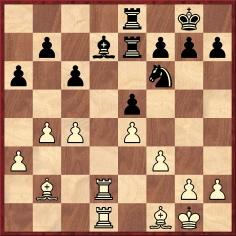
22 a4 Rd8 23 b5 c5 24 Rd6 axb5 25 cxb5 Ra8 26 Ba3 Rxa4 27 Bxc5 Be6 28 Rd8+ Re8 29 Rxe8+ Nxe8 30 Rd8 g6 and White won.
After Black’s 30th move Golombek commented:
‘Here it looked at first R-R7, then B-Q2, P-R3 and P-B4 and then back to P-R3 and P-KN3. It spent 29 minutes 44 seconds on this hopeless procedure and staggered on for another ten moves before I mated it.’
(7142)
It is in the nature of most chess databases that they give unsubstantiated, dubious or inaccurate material unquestioningly. Careful corrective work would surely be a better use of anybody’s time than, for instance, involvement in those inconsequential yet pestilential ‘discussion groups’.)
(7385)
From page 357 of the December 1949 Chess Review:
‘The claim is made that it is now possible to solve two-move chess problems automatically by means of an electronic calculating machine. Even if this device portends the invention of a monster that can play a whole game, the world of human chess, it is safe to predict, will stick resolutely to its time-honored methods of enjoying the royal game. It is fascinating, however, to speculate on whether a machine could ever defeat a Botvinnik and outstrip Ambrose Bierce’s fantastic thriller Moxon’s Master.’
(7536)
Below is the opening of an article by G.H. Diggle published in the April 1984 Newsflash and on page 1 of volume two of Chess Characters (Geneva, 1987):
‘“The Lloyds Bank Programme” (so reads the envious Badmaster in the March Newsflash) “organized by British Chess Officials and continually identifying and encouraging new talent, aims to help young people in schools and universities to improve their game to top level standards.” Oh, it does, does it? And what does it do to help the old people – worthy pensioners with 50 years’ addled chess fermenting in their brains – to make some stand against these pampered young sixth-formers who invariably wipe them off the board nowadays? When are the “poor old souls” to expect their “meals on wheels” to be accompanied by a visiting Grandmaster to bring them up to date with the Nimzo-Indian, Keene’s Flank Openings, and other horrors of that sort? At present, they are just left to sit at home playing some cheap Computer purchased with their hard-earned savings. The BM himself was once ensnared into taking on one of these brutes. It would occasionally “talk” between the moves – whenever the BM blundered there came clanking out from its bowels some slotted sarcasm such as “IS THIS A TRAP, I WONDER?” After exclaiming, “Enough of this programmed impudence!”, the BM has reverted ever since to playing human beings, finding even the young ones far less objectionable.
(7895)
Charles Sullivan (Davis, CA, USA) submits a game which he believes has not previously been published:
Max Euwe – Sargon 2.5
Detroit, 29 October 1979
King’s Fianchetto Defence
1 e4 g6 2 d4 Bg7 3 g3 Nf6 4 Bg2 d6 5 Ne2 O-O 6 O-O e5 7 c3 c5 8 d5 b6 9 f4 Bb7 10 fxe5 dxe5 11 Nd2 Nbd7 12 a4 Qc7 13 Nc4 Rae8 14 Qb3 Ng4 15 a5 bxa5 16 Rxa5 a6 17 h3 Ngf6 18 g4 Rb8 19 Qa2 Rfe8 20 Ng3 (Mr Sullivan points out the possibility 20 g5 Nh5 21 Rxf7.) 20...Bf8 21 g5 Nh5 22 Nxh5 gxh5 23 h4 Nb6 24 Nxb6 Qxb6 25 Be3 Rbd8 26 b4 Rc8
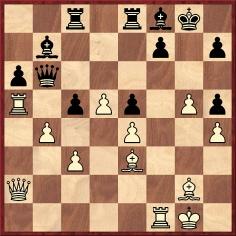
27 Qf2 Qg6 28 bxc5 Rcd8 29 c6 Bc8 30 Bb6 Rd6 31 Bc7 Re7 32 Bxd6 Qxd6 33 Qf6 Qxf6 34 Rxf6 Bg7 35 Rf1 Ra7 36 d6 Be6 37 d7 Ra8 38 Rxa6 Rb8 39 c7 Rf8 40 d8(Q) h6 41 Rxe6 fxe6 42 Rxf8+ Bxf8 43 Qxf8+ Kxf8 44 c8(Q)+ Kg7 45 Qxe6 hxg5 46 hxg5 Kf8 47 Qf6+ Ke8 48 g6 Kd7 49 Bh3+ Ke8 50 Qf7+ Kd8 51 Qd7 mate.
Our correspondent comments:
‘I recorded the game while standing next to Euwe. It was played between rounds two and three of the Tenth North American Computer Chess Championship in Detroit. Both sides played a move every five to 15 seconds or so, and Euwe stood for the entire game, which lasted approximately 20 minutes. Although he had no difficulty dispatching the computer, I was struck by how carefully he seemed to play, certainly not making his moves at blitz speed.’
(7949)
Christian Sánchez draws attention to a brief video sequence of the Ajedrecista in action.
(8391)
Early cartoons depicting computers/machines and chess are always welcome. From page 65 of the December 1946 CHESS:
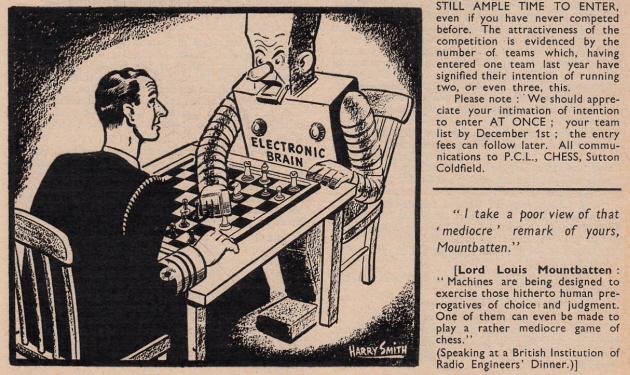
(8464)
‘Is this the beginning of the end for chess, or the end of the beginning?’
From page 38 of CHESS, November 1949:
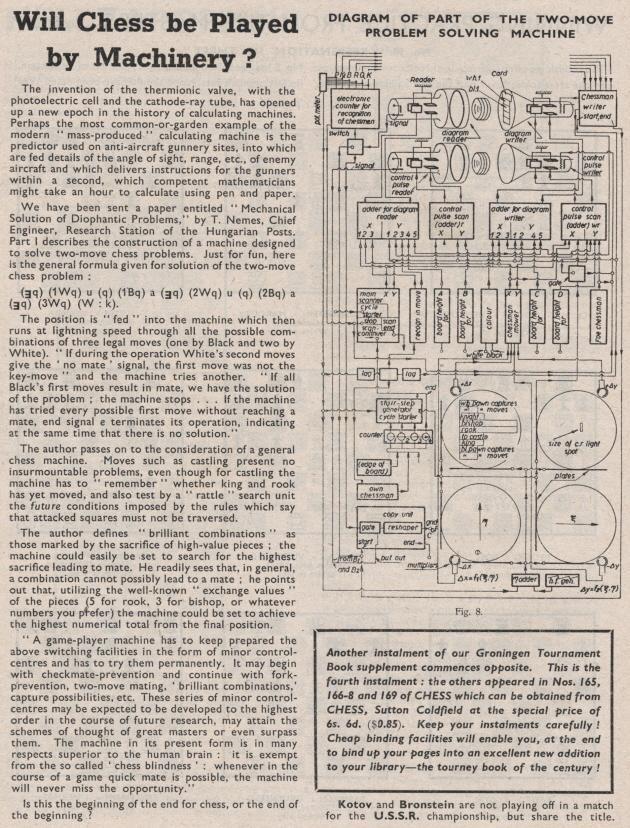
(8582)
From page 201 of The Chess Masters on Winning Chess by Fred Reinfeld (New York, 1960):
‘It is curious that there are so many misconceptions about chess, not only among nonplayers but even among its devotees. Perhaps the most indestructible of these legends is that chess is a rigorous duel of mighty intellect clashing with another mighty intellect. A won game is therefore, according to this version, a masterpiece of logic, forethought, calculation, precision, and the like.
This is what chess may become some day when it is played only by electronic computers. But as long as it is played by human beings, chess will remain what it has always been – a struggle full of mistakes, oversights, errors of judgment, omissions, inexactitudes, vicissitudes, a blunder answered with a bigger blunder.
We may tsk-tsk over these lapses, yet – dare we say it? – we rather enjoy seeing our betters get their comeuppance from time to time. And in any event, we realize sooner or later, from games like the following one, that most of the color, suspense, tension and kaleidoscopic variety of this wonderful game arise from the mistakes of the players. Nothing palls like too much perfection; we can best appreciate it in patches that stand out against a background of struggle, error and befuddlement.’
Reinfeld then gave Yates v Kmoch, London, 1927, with a critical examination of the latter’s notes. Kmoch had originally annotated the game on pages 237-239 of the Wiener Schachzeitung, August 1927.
(9495)
From page 141 of A History of Chess by Jerzy Giżycki (London, 1972):

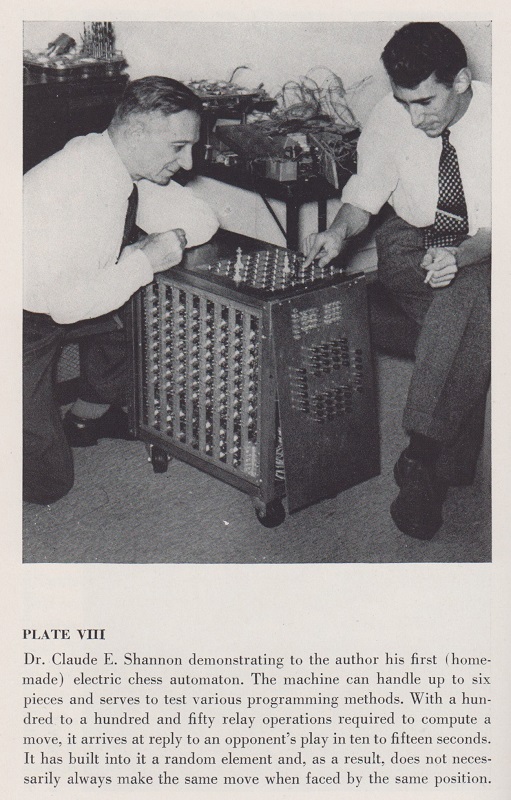
The Adventure of Chess by Edward Lasker (New York, 1950), opposite page 201
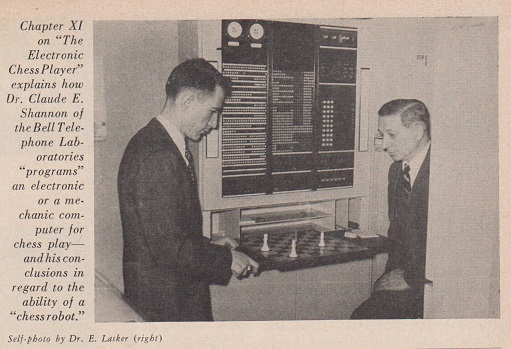
Chess Review, January 1951, page 13.
(10324)
An article ‘Experiments in Chess on Electronic Computing Machines’ by P. Stein and S. Ulam on pages 13-16 of the January 1957 Chess Review was introduced by Edward Lasker and ended with three games of ‘6x6 chess’. For example:
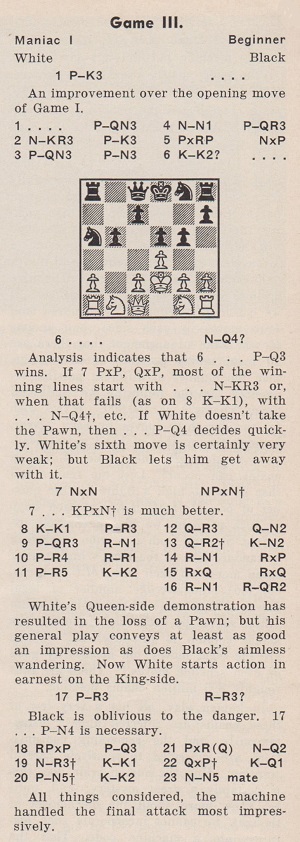
The three games, together with a summary of the rules, were published in the entry on Los Alamos Chess on pages 175-176 of The Encyclopedia of Chess Variants by D.B. Pritchard (Godalming, 1994).
(10325)
On the front cover of the July 1959 Chess Review:
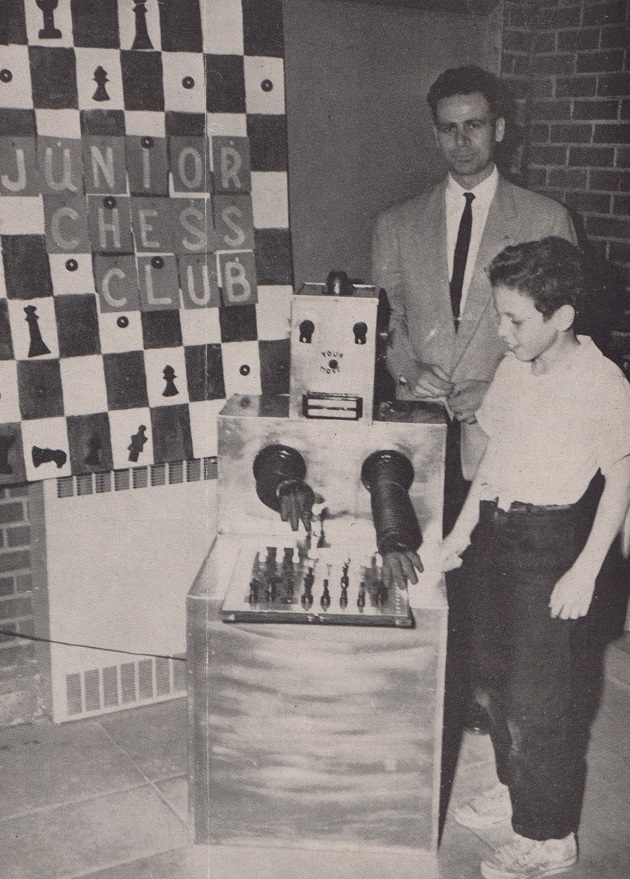
From page 199 of the same issue:
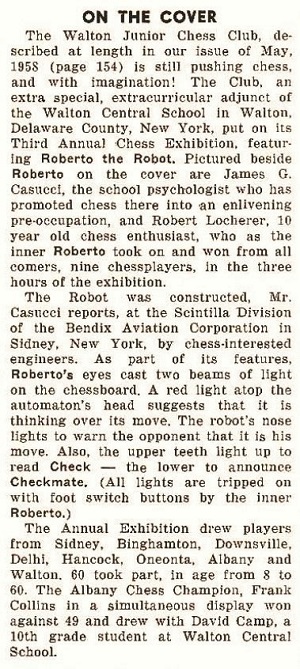
(10377)
This cutting from page 1 of Chess Life, 5 September 1958 has been forwarded by Eduardo Bauzá Mercére (New York, NY, USA):
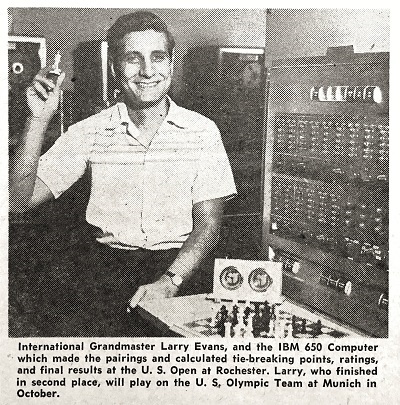
Which was the first open tournament where all the pairings were made by a computer?
(11097)
Addition on 21 April 2024:
Chess computers can take the shine off almost any game, however brilliant.
To the Chess Notes main page.
To the Archives for other feature articles.
Copyright: Edward Winter. All rights reserved.